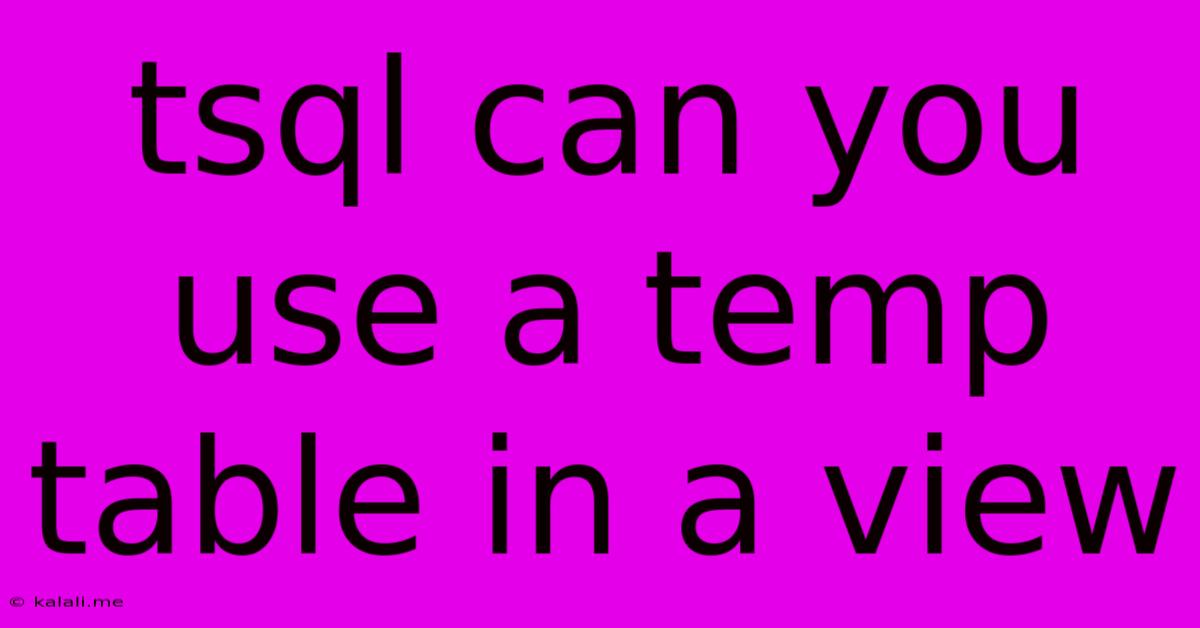Tsql Can You Use A Temp Table In A View
Kalali
Jun 05, 2025 · 3 min read

Table of Contents
Can You Use a Temp Table in a T-SQL View? The Definitive Answer
Creating efficient and reusable SQL code is crucial for any database developer. Views are a powerful tool for simplifying complex queries and providing a more manageable interface to data. But what happens when you need the functionality of a temporary table within a view? The short answer is: no, you cannot directly use a temporary table (#table) inside a T-SQL view. This article will explain why and offer alternative solutions to achieve the same results.
This restriction is due to the fundamental nature of views. A view is essentially a stored query; it doesn't exist as a physical table in the database. Temporary tables, on the other hand, are created dynamically and only exist for the duration of a connection or session. Because a view is a reusable, persistent object, it cannot rely on the ephemeral nature of a temporary table, which might not exist when the view is accessed.
Why the Limitation?
The inability to use temporary tables in views is primarily due to the following reasons:
- Session Dependency: Temporary tables are session-specific. A view needs to be accessible from any session, independent of the creator's session.
- Concurrency Issues: Allowing temporary tables in views could lead to unpredictable behavior and concurrency issues. Multiple users accessing the view might encounter conflicting temporary table data.
- Performance and Scalability: Managing temporary tables within a view would introduce unnecessary overhead and reduce the scalability of the database.
Alternative Approaches: Achieving the Desired Functionality
While you cannot directly use temporary tables within views, several effective workarounds exist:
-
Table-Valued Functions (TVFs): TVFs provide a cleaner and more efficient alternative to temporary tables within stored procedures or views. You can create a TVF that performs the necessary operations and returns a result set. This result set can then be used within your view.
CREATE FUNCTION dbo.MyTableValuedFunction (@parameter INT) RETURNS @Results TABLE ( Column1 INT, Column2 VARCHAR(50) ) AS BEGIN -- Your logic here to populate @Results table INSERT INTO @Results (Column1, Column2) SELECT 1, 'Data 1' UNION ALL SELECT 2, 'Data 2'; RETURN; END; CREATE VIEW MyView AS SELECT * FROM dbo.MyTableValuedFunction(1); -
Inline CTEs (Common Table Expressions): For simpler scenarios, using Common Table Expressions (CTEs) within your view can often replicate the functionality of a temporary table. CTEs are defined within the scope of a single query and offer a structured approach to breaking down complex logic.
CREATE VIEW MyView AS WITH MyCTE AS ( SELECT column1, column2 FROM MyTable WHERE condition ) SELECT * FROM MyCTE; -
Stored Procedures: If your logic is very complex, encapsulating it within a stored procedure is a good approach. This maintains database integrity while permitting temporary table use. You can then create a view which simply calls this stored procedure.
-
Global Temporary Tables (##table): Global temporary tables exist for the duration of the database connection, not just a single session. While still generally avoided within views due to potential concurrency issues, they represent a more flexible option than session-scoped temporary tables, particularly in very specific circumstances where concurrency is not a concern. However, using a global temporary table still comes with significant risk and is usually discouraged.
Best Practices
The best approach depends on your specific needs. Always prioritize simplicity, readability, and maintainability. For most scenarios, Table-Valued Functions (TVFs) and CTEs provide robust and efficient alternatives. Consider using a stored procedure only when the logic becomes too complex for a TVF or CTE. Remember to carefully consider the implications of using global temporary tables, as they can introduce significant complications. Avoid them unless absolutely necessary.
By understanding the limitations and adopting these alternative strategies, you can effectively manage data processing within your views, ensuring efficient and well-structured T-SQL code. Remember to thoroughly test your implementation to guarantee optimal performance and accuracy.
Latest Posts
Latest Posts
-
Dnd Death Ward How Long Does It Last
Jun 07, 2025
-
Does Greyhound Accept Prison Id Bracelets In Virginia
Jun 07, 2025
-
Why Did Eren Fight Alongside Zeke
Jun 07, 2025
-
How To Send Prompt To Chatgpt With A Query String
Jun 07, 2025
-
How To Find A Key Fob
Jun 07, 2025
Related Post
Thank you for visiting our website which covers about Tsql Can You Use A Temp Table In A View . We hope the information provided has been useful to you. Feel free to contact us if you have any questions or need further assistance. See you next time and don't miss to bookmark.